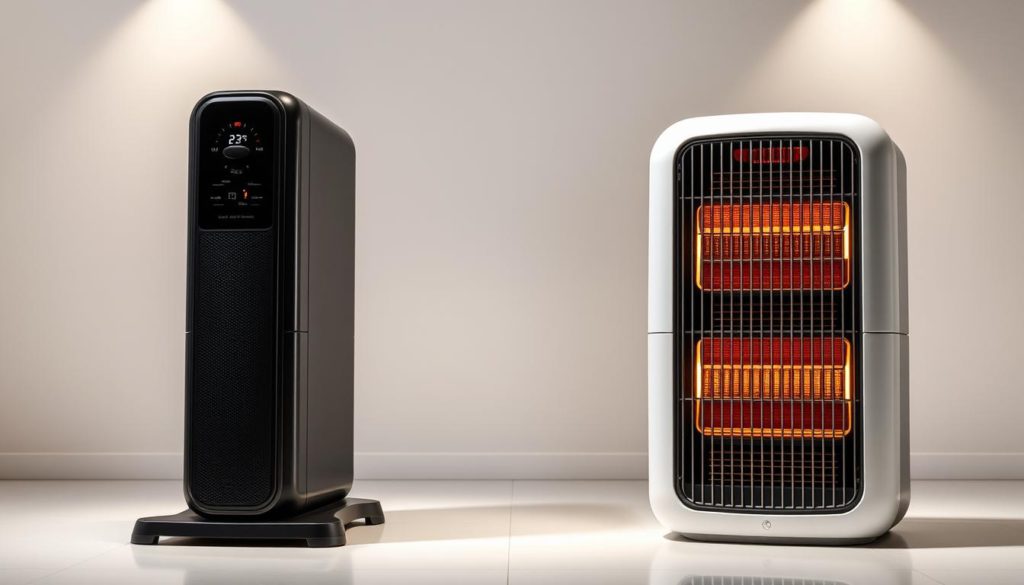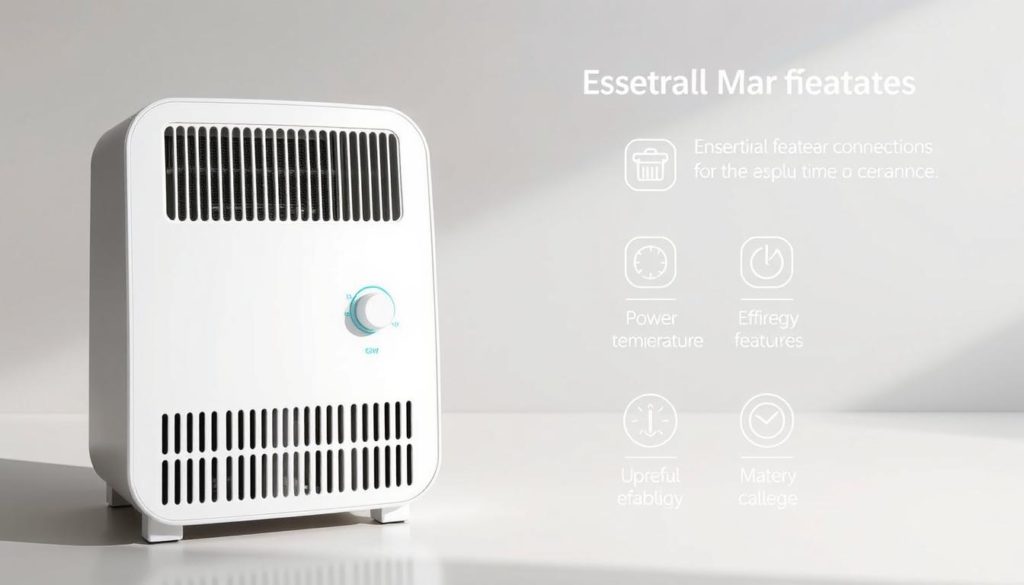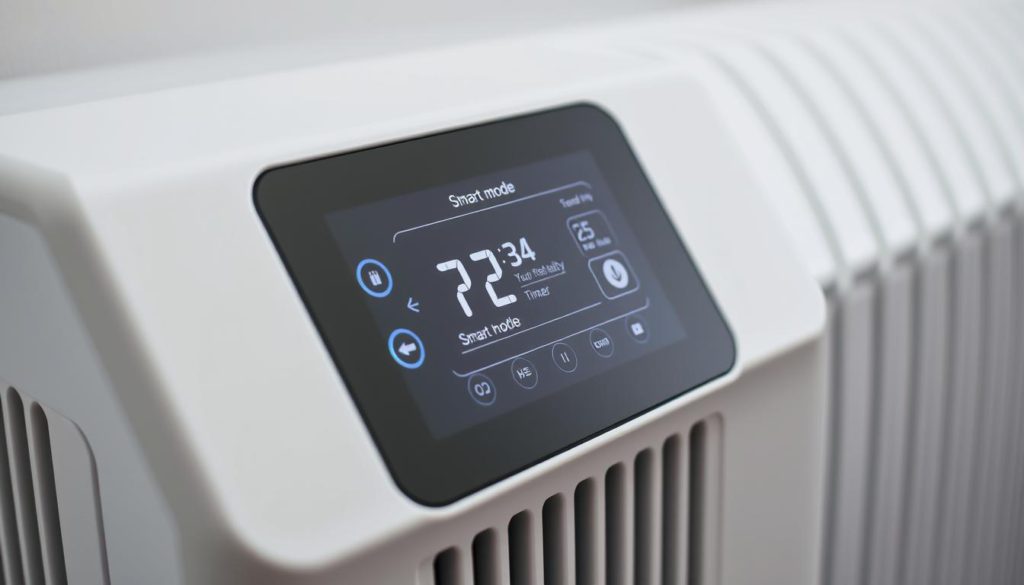What if your heater could slash your energy bills while keeping your space perfectly cozy? Modern heating solutions blend innovation with practicality, but navigating the options requires clarity. This guide cuts through the noise to help you find a system that balances warmth, safety, and long-term savings.
- Introduction to Energy-Efficient Heating
- Types of Electric and Ceramic Heaters
- Heating Technologies Demystified
- The Ultimate Guide to Choosing an Energy-Efficient Heater
- Maximizing Energy Efficiency & Reducing Costs
- Safety Features and Installation Tips
- Maintenance and Troubleshooting of Your Heater
- Advanced Features & Smart Controls for Modern Heaters
- Conclusion
- FAQ
Not all heaters are created equal. From compact electric models to advanced ceramic designs, today’s technology offers smarter ways to manage electrical energy use. You’ll discover how features like programmable thermostats and oscillation improve efficiency—without sacrificing comfort.
We’ll break down how different heaters work, compare costs, and highlight safety tips. Whether you’re heating a small office or a large living area, understanding technical specs ensures you avoid overspending. Ready to explore options that reduce environmental impact and monthly expenses?
Key Takeaways
- Compare electric, ceramic, and oil-filled heaters for optimal energy savings
- Learn how smart features like timers and sensors enhance efficiency
- Discover installation best practices to maximize heat distribution
- Understand maintenance routines to extend heater lifespan
- Evaluate safety certifications for worry-free operation
Introduction to Energy-Efficient Heating
Imagine trimming your winter energy costs while maintaining consistent warmth. Energy-efficient heating systems achieve this balance by using less electricity to generate the same heat output as traditional methods. This approach benefits both your wallet and the environment.
Understanding Your Heating Needs
Start by measuring your room’s square footage. Larger spaces require heaters with higher wattage, while smaller areas work well with compact models. Consider ceiling height and insulation quality too—poorly insulated rooms lose heat faster.
Usage patterns matter. Do you need all-day warmth in a home office or quick bursts of heat in a bathroom? Programmable thermostats help tailor heating schedules to match daily routines, preventing energy waste.
Benefits of Energy-Efficient Solutions
Modern heaters cut energy use by up to 30% compared to traditional heating systems. Look for features like auto-shutoff and adjustable thermostats that prevent overheating. These upgrades also reduce fire risks in busy households.
Beyond savings, efficient models distribute heat evenly. Ceramic and infrared options avoid the dry air common with older units. You’ll notice improved comfort without constant temperature adjustments.
- Compare EnergyGuide labels to identify low-consumption models
- Prioritize heaters with timers for unused rooms
- Seek certifications like UL or ETL for safety assurance
Types of Electric and Ceramic Heaters

Selecting the right heater type depends on how quickly you need warmth and how long you plan to use it. Electric and ceramic models dominate the market, but oil-filled and parabolic options offer unique advantages for specific scenarios.
Electric Heaters vs. Ceramic Heaters
Portable electric heaters work best for quick, focused warmth. They use metal coils to generate heat but can dry out air. Ceramic heaters employ PTC (positive temperature coefficient) elements that self-regulate to prevent overheating—ideal for bedrooms or nurseries.
MCH (metal ceramic hybrid) heaters combine ceramic plates with aluminum chambers. These units heat faster than standard PTC models while maintaining energy efficiency. Both types suit small to medium rooms but differ in noise levels and maintenance needs.
| Feature | Electric Heaters | Ceramic Heaters |
|---|---|---|
| Heat-Up Time | 15-30 seconds | 5-10 seconds |
| Energy Use | Higher wattage | Self-regulating |
| Noise Level | Moderate fan | Quiet operation |
Overview of Oil Burner and Oscillating Parabolic Heaters
Oil-filled radiators provide steady, long-lasting heat without fans. Their sealed diathermic oil circulates warmth silently—perfect for overnight use in large spaces. These units take longer to heat up but maintain temperatures efficiently.
Oscillating parabolic heaters use quartz tubes to emit infrared radiation. The rotating design spreads heat across wide areas quickly. While they consume more energy during use, their targeted heating reduces runtime in drafty rooms or workshops.
- Match heater size to room dimensions: 10 watts per square foot
- Prioritize oscillation for open floor plans
- Choose oil heaters for allergy sufferers (no air movement)
Heating Technologies Demystified
At the core of every heater lies its heating element—the component that transforms electricity into warmth. Understanding these technologies helps you balance speed, efficiency, and safety in your heating solutions.
Metal vs. Ceramic and Semiconductor Heating Elements
Traditional metal coils heat up fast but waste energy through uneven distribution. They convert 98% of electrical energy to heat but cycle on/off frequently, causing temperature swings. Ceramic and semiconductor elements use PTC materials that self-regulate. These reduce power draw by 15-20% as they reach optimal temperatures.
Semiconductor heaters add microchips to control heat output precisely. This prevents hotspots and extends component life. Both types excel in energy-efficient electric systems where consistent warmth matters more than rapid bursts.
Thick Film Heating Elements Explained
Thick film technology prints conductive paste onto ceramic plates, creating ultra-thin heating layers. This design spreads heat evenly across surfaces, eliminating cold zones. Units warm 40% faster than standard ceramic models while using less power.
These elements integrate seamlessly with smart thermostats and safety features. Automatic shutoffs trigger if internal sensors detect overheating or tipped units. Look for reinforced power cords and UL certification when choosing these advanced systems.
- Metal elements: High initial heat, ideal for garages or workshops
- Ceramic/semiconductor: Steady warmth for bedrooms and offices
- Thick film: Precision heating with silent operation
The Ultimate Guide to Choosing an Energy-Efficient Heater

Your heater’s features directly impact its efficiency and your comfort. Smart choices here prevent energy waste while ensuring consistent warmth. Let’s explore what separates basic models from high-performing units.
Key Features Checklist
Start with adjustable thermostats. These maintain your preferred temperature without manual adjustments. Multiple heat settings let you balance warmth and energy use—low for maintenance, high for quick heating.
Safety mechanisms are non-negotiable. Tip-over switches and overheat protection automatically shut units off during accidents. For families with kids or pets, these features are essential.
| Feature | Importance | Examples |
|---|---|---|
| Programmable Thermostat | Reduces energy use by 12-15% | 7-day schedules, zone heating |
| Wattage/BTU Rating | Matches room size | 1500W for 150 sq ft |
| Portability | Enables multi-room use | Built-in handles, |
| Smart Controls | Remote temperature management | Wi-Fi connectivity, voice commands |
Compare wattage and BTU output to your space. Undersized units overwork, increasing power bills. Oversized models create hot/cold zones. Portable electric heaters excel here—their compact size delivers focused warmth where needed.
Modern functions like app integration transform heating control. Program schedules around your routine or adjust settings from bed. These upgrades make ceramic heating systems 23% more efficient than basic models.
Maximizing Energy Efficiency & Reducing Costs
Balancing warmth and affordability starts with understanding your heater’s energy use. Simple math and smart features can cut costs without sacrificing comfort. Let’s break down the numbers and tools that make it possible.
Crunching the Numbers: Energy Use Basics
Calculate hourly costs by multiplying your heater’s wattage by local electricity rates. A 1,500-watt unit running 5 hours daily at $0.12/kWh costs $0.90 per day. Multiply this by 30 for monthly estimates.
| Wattage | Daily Use (5hr) | Monthly Cost |
|---|---|---|
| 750W | $0.45 | $13.50 |
| 1,500W | $0.90 | $27.00 |
| 2,000W | $1.20 | $36.00 |
Smart Tech for Smarter Savings
Eco-modes automatically lower output when rooms reach target temperatures. Pair this with programmable timers to disable heating during sleep hours or workdays. Smart thermostats take it further—adjust settings remotely if plans change.
Zone heating strategies focus warmth where you need it most. Close doors to unused spaces and use smaller electric heaters in high-traffic areas. This approach can reduce overall energy bills by 20% compared to whole-house systems.
Upgrading to energy-efficient electric heaters with these functions slashes long-term costs. You’ll also shrink your environmental impact—efficient models produce 15% fewer emissions than standard units.
Safety Features and Installation Tips
Proper heater setup prevents accidents before they happen. Modern units include built-in safeguards, but your placement and maintenance choices determine their effectiveness. Let’s explore how to create a secure heating environment while maximizing warmth.
Essential Safety Protocols
Tip-over switches and overheat protection are non-negotiable in any heater. These features automatically cut power if units tilt or exceed safe temperatures. Pair them with cool-touch exteriors to prevent burns, especially in homes with curious children or pets.
Always place heaters on flat, non-flammable surfaces like tile or stone. Keep them 3 feet away from curtains, furniture, and bedding. For portable electric models, avoid high-traffic areas where they might get knocked over.
- Route power cords along walls—never under rugs or furniture
- Use surge protectors to prevent electrical overloads
- Check for frayed wires monthly and replace damaged cords immediately
Wall-mounted heaters need 12 inches of clearance on all sides. Install them at least 6 inches above floors to avoid dust buildup. Follow manufacturer guidelines for mounting brackets and electrical connections to maintain warranties.
Test safety features quarterly. Tilt units slightly to confirm automatic shutoffs work. Wipe vents free of lint to ensure proper airflow and reduce fire risks. These simple habits keep your energy-efficient electric heaters running safely for years.
Maintenance and Troubleshooting of Your Heater
Keeping your heater in top shape requires consistent care and quick problem-solving. A well-maintained unit runs efficiently, cuts energy costs, and avoids unexpected breakdowns. Let’s explore practical strategies to preserve your heater’s performance year-round.
Regular Cleaning and Seasonal Checks
Dust buildup is the #1 enemy of heating systems. Blocked vents force your heater to work harder, increasing power use by up to 18%. Unplug portable electric models weekly and wipe grilles with a microfiber cloth. For ceramic heaters, use compressed air to clear debris from internal components.
Before each heating season:
- Inspect power cords for cracks or fraying
- Test safety shut-off features by gently tilting the unit
- Check ceramic heating elements for discoloration
Resolving Common Heater Issues
If your heater won’t turn on, first verify outlet functionality. Reset circuit breakers and ensure thermostats aren’t set below room temperature. Uneven heat distribution often signals blocked airflow—reposition the unit at least 3 feet from walls.
| Problem | Likely Cause | Quick Fix |
|---|---|---|
| Clicking noises | Expanding metal parts | Normal operation (no action needed) |
| Burning smell | Dust on heating elements | Run at high heat in ventilated area for 20 minutes |
| Cold spots | Faulty oscillation | Lubricate motor gears with silicone spray |
“Invest 15 minutes monthly in maintenance, and your heater will repay you with years of reliable service,” advises HVAC specialist Mark Renolds. Always consult manufacturer guides before disassembling units—improper handling voids warranties.
Schedule professional inspections every 2-3 years for wall-mounted systems. Technicians check electrical connections and calibrate thermostats, ensuring your ceramic heating system operates at peak efficiency.
Advanced Features & Smart Controls for Modern Heaters

Your heating system just got smarter. Today’s energy-efficient electric heaters connect to your home network, letting you adjust warmth from anywhere. These innovations transform how you manage comfort while cutting energy waste.
Remote Management & Adaptive Learning
Wi-Fi-enabled models sync with smartphone apps. Change temperatures during your commute or turn units off accidentally left running. One study found users save 11% on heating bills through remote adjustments alone.
Smart thermostats learn your patterns. They lower output when rooms empty and preheat spaces before you arrive. This adaptive tech reduces electrical energy use without sacrificing comfort.
| Feature | Benefit | Energy Savings |
|---|---|---|
| 7-Day Scheduling | Matches work/weekend routines | Up to 14% |
| Geofencing | Auto-off when you leave | 8-12% |
| Voice Commands | Hands-free adjustments | 5-7% |
Portable heaters with these controls offer flexibility. Move them between rooms while maintaining efficiency settings. Safety features like usage reports help identify when filters need cleaning or components require maintenance.
“Smart heating isn’t about complexity—it’s about effortless efficiency,” notes HVAC engineer Lisa Tan. With real-time energy tracking and automated adjustments, you’ll make informed decisions that balance warmth and cost.
Conclusion
Finding the right balance between cozy warmth and energy savings transforms how you experience cold seasons. Modern units cut energy bills by up to 30% compared to traditional heating while maintaining steady comfort. Whether selecting compact ceramic models or smart energy-efficient electric systems, matching size to your space ensures optimal performance.
Prioritize overheat protection and proper maintenance to extend your heater’s lifespan. Advanced features like app-controlled thermostats and zone heating refine your strategy—reducing environmental impact without compromising air quality. These tips help avoid common pitfalls, from uneven heat distribution to safety hazards.
This guide equips you to make informed decisions when upgrading your home heating. Use these insights to choose a unit that fits your lifestyle—keeping rooms warm without wasting energy or money. Your ideal solution combines smart tech, safety, and efficiency for year-round reliability.
FAQ
What’s the difference between electric and ceramic heaters?
Electric heaters use metal coils to generate heat, while ceramic heaters rely on ceramic plates. Ceramic models heat up faster, distribute warmth more evenly, and are often more energy-efficient. Brands like DeLonghi and Lasko offer both types, but ceramic options like the Lasko 755320 prioritize safety and efficiency.
How do I choose the right heater size for my room?
Measure your room’s square footage and match it to the heater’s wattage. A 1,500-watt unit typically heats 150 sq. ft. For larger spaces, consider oscillating parabolic heaters like the Dyson Hot+Cool, which circulate air efficiently. Always check manufacturer guidelines for sizing accuracy.
Are energy-efficient heaters safer than traditional models?
Yes. Modern energy-efficient heaters include safety features like tip-over switches and overheat protection. Brands like Honeywell integrate these into models such as the Honeywell HZ-8900C, reducing fire risks. Ceramic heaters also stay cooler to the touch, making them safer around kids or pets.
Can smart thermostats reduce heating costs?
Absolutely. Smart thermostats like Nest or Ecobee learn your schedule and adjust temperatures automatically. Pairing them with a compatible heater, such as the DeLonghi Dragon4, ensures optimal energy use, cutting bills by up to 10-15% annually.
How often should I clean my ceramic heater?
Dust accumulation can hinder performance. Clean vents monthly with a soft brush and wipe surfaces with a dry cloth. For models like the Lasko 754200, unplug the unit first. Seasonal checks before winter ensure efficient operation and extend the heater’s lifespan.
Do thick film heating elements save energy?
Thick film elements, used in brands like Glen Dimplex, heat up rapidly and distribute warmth evenly. They consume less power than traditional coils, making them ideal for portable electric heaters. Their slim design also suits compact spaces without sacrificing output.
What’s the best way to reduce environmental impact with heaters?
Opt for ENERGY STAR-certified models, such as the Vornado AVH10, which meet strict efficiency standards. Pair them with renewable energy sources like solar panels. Avoid leaving units on standby—use programmable timers to limit unnecessary use.
Can I use a portable heater in a bathroom?
Only if it’s rated for high-moisture areas. Look for IP24-rated models like the Dr. Infrared Heater DR-968, designed for bathrooms. Avoid placing any heater near water sources, and ensure cords are dry. Safety certifications from UL or ETL are a must.
Why does my oil-filled radiator heater take longer to warm up?
Oil-filled heaters, like the Pelonis NY1507-14A, use convection to heat oil, which then radiates warmth. While slower to start, they retain heat longer, making them cost-effective for prolonged use. They’re ideal for bedrooms or living rooms where steady warmth matters.
How do I troubleshoot a heater that won’t turn on?
First, check the power cord and outlet. Reset the circuit breaker if needed. For models with a thermostat, like the Honeywell HZ-8900C, ensure settings aren’t too low. If the issue persists, consult the manual or contact customer support—DIY repairs can void warranties.
